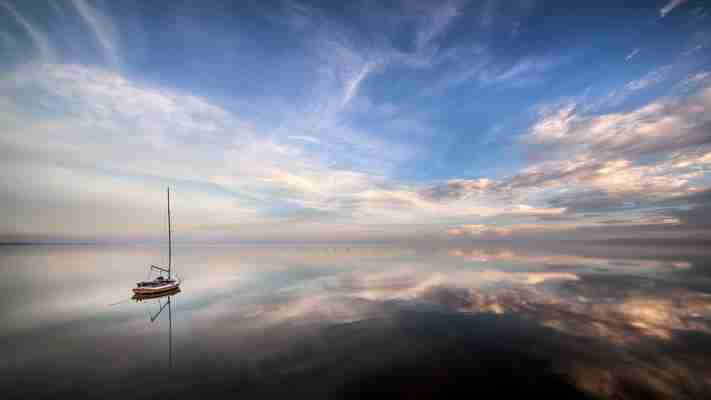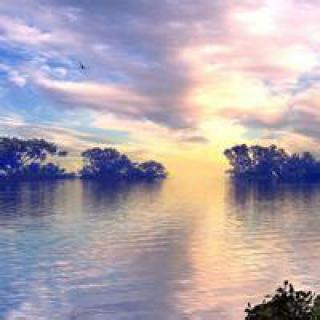California’s ghostly disappearing sea
Article continues below

Salton Sea, California
Covering 343 sq miles of the Sonoran Desert southeast of Palm Springs, the creation of the Salton Sea, California’s largest lake, was entirely accidental.In spring 1905, during a period of heavy rain and snowmelt, the Colorado River swelled and burst through an irrigation canal in the Imperial Valley, put in place by the California Development Company to fertilise farmland across a region that was once home to a prehistoric sea. Water poured into the basin and submerged the town of Salton, the Torres-Martinez Native American reserve and a section of the Southern Pacific Railroad. (Credit: Tom Grubbe/Getty Images)

Salton Sea, California
Engineers and nearly 2,000 workers laboured tirelessly to construct a dam out of boulders and wood; after two years, they were finally able to halt the flood. At this point, the Salton Sea [measured](http://www.parks.ca.gov/?page_id=639) 45 miles long by 20 miles wide. At 234ft below sea level, the newly formed sea is one of the lowest lakes in the world. Despite its location in the desert, with extremely low annual rainfall and high temperatures, the Salton Sea became a sanctuary for biodiversity. The California Department of Fish and Game (CDFG) stocked the lake with a variety of fish species; in 1930, the area was designated a wildlife refuge; and by 1985, a CDFG study found the Salton Sea to be the most productive marine fishery in California. (Credit: Michael Dwyer/Alamy)

Salton Sea, California
The lake also attracted flocks of birds; at one time the [Sonny Bono Salton Sea National Wildlife Refuge](https://www.fws.gov/refuge/sonny_bono_salton_sea/) had at least 400 species of migratory birds and 93 species of nesting birds. It became an important habitat for endangered species like the yuma clapper rail and the American white pelican. Today, the Salton Sea is [one of seven](http://www.sci.sdsu.edu/salton/ForBirdsAttractiveThreat.html) major wetlands along the Pacific Flyway migratory route. (Credit: Kurt Krieger/Getty Images)
Salton Sea, California
By the 1950s and ‘60s, real-estate developers were touting the Salton Sea as a ‘miracle in the desert’, comparing it to the French Rivera. Multimillion-dollar yacht clubs, summerhouses, hotels and restaurants sprung up along the lake, transforming the area into a thriving waterside resort that welcomed 1.5 million tourists each year. Holidaymakers from Los Angeles – including the band The Beach Boys – made the 150-mile journey to sunbathe on the lake’s shores. (Credit: David McNew/Getty Images)
Salton Sea, California
But the fun was short lived. The Salton Sea’s ecosystem quickly became too hostile to support living organisms. With little rain and no drainage outlet, the lake was evaporating, which was causing the water’s salinity to rise. Meanwhile, agricultural runoff from pesticides and fertilisers added to the lake’s toxicity. Then, in 1970, tropical rainstorms flooded the lakeside towns, damaging them beyond repair. By the 2000s, the population of the Salton Sea area had significantly diminished. Homes were left abandoned, and, the water now 25% saltier than the Pacific Ocean caused the lake’s fish population to die out. The white, sandy beaches once adored by visitors were left deserted, littered with decaying remnants of a lost golden age. (Credit: Ed Freeman/Getty Images)
Salton Sea, California
Within a century, the Salton Sea had transformed from a welcome accident to an environmental nightmare. The lake continued to disappear, leaving behind a dusty landscape contaminated with traces of arsenic and pesticides. Today, Imperial County has some of the worst air pollution in the US and the highest rate of asthma-hospitalisation in California. (Credit: Jill Schneider/Getty Images)
Salton Sea, California
In order to prevent further damage to public health and wildlife, the State of California recently invested $383 million to the preservation and development of Salton Sea. Their proposed [plan, which was released in March,](http://resources.ca.gov/docs/salton_sea/ssmp-10-year-plan/SSMP-Phase-I-10-YR-Plan-with-appendices.pdf) requires the importation of 800,000 acre-feet of water from the Colorado River to the site by the end of 2017. According to the plan, efforts to restore one of California’s most important wildlife habitats will continue through the early 2020s. Starting in 2018, the state will partner with organisations like the University of California and Audubon to artificially construct a variety of wet and dry habitats to suppress the spread of dust, decrease the salinity of the sea and restore the bird and fish populations. (Credit: Peter Unger/Getty Images)

